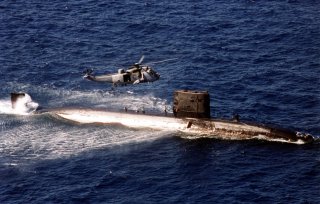Former Prime Minister Abbott Urges Australia to Purchase Subs as a Stopgap
The Australian government should explore the extent to which these submarines can be used as a training platform or as an “addition to the order of battle in the Western Pacific.”
At a recent event hosted by the Wilson Center, former Australian prime minister Tony Abbott said that Canberra should purchase Los Angeles-class or Trafalgar-class submarines as a stopgap solution while it awaits the new nuclear submarines it is procuring as part of the AUKUS trilateral security pact with the United States and United Kingdom. The Los Angeles-class is well known as the time-tested backbone of the U.S. Navy’s submarine force, but what is the Trafalgar-class, and why might the Royal Australian Navy (RAN) be interested in it?
The Trafalgar-class was conceived as a further development of the innovative Swiftsure-class submarines. The lead vessel Trafalgar was laid down in 1979 and commissioned in 1983. The Trafalgar’s hull is lined with anechoic tiles to absorb sound waves, making the submarine more difficult to track. The Trafalgar’s internal layout largely resembles its Swiftsure predecessor except for an upgraded nuclear reactor and more robust sonar array. The Trafalgar-class models support five 533mm torpedo tubes for a total of thirty torpedoes and missiles, including Tomahawk Block IV cruise missiles and the British Royal Navy’s Spearfish torpedoes.
The Trafalgar-class was originally intended to target enemy nuclear ballistic missile submarines (SSBNs), but has since grown into more of a hybrid multipurpose role that includes surveillance and reconnaissance missions. Though the Trafalgar vessels did not see significant action during the late cold war, several Trafalgar-class vessels went on to take an active part in the UK’s military contribution to the war on terror. Trafalgar-class submarines launched tomahawk cruise missiles against land targets in Afghanistan and Iraq. More recently, tomahawk-equipped Trafalgar submarines reportedly participated in combat operations during the 2011 military intervention in Libya.
Seven Trafalgar-class boats were built. Of these, the first four models of the class—Trafalgar, Turbulent, Tireless, and Torbay—have been decommissioned. The fifth, Trenchant, is pending decommission while the last two, Talent and Triumph, remain in service. The Trafalgar-class is being steadily phased out in favor of the Royal Navy’s modernized Astute-class submarines, which themselves are an advanced development of Trafalgar-class boats.
Abbott raised the prospect of purchasing the last Trafalgar-class boats, which are likely due to retire in coming years. Abbott is urging the Australian government to explore the extent to which these submarines can be used as a training platform or as an “addition to the order of battle in the Western Pacific,” presumably in the event of a major military clash with the People’s Republic of China. “I think we need to be prepared to think the unthinkable. I think it's entirely possible that at some point in time, perhaps quite soon, China might up the ante,” said Abbott, referring to a regional conflict sparked by a potential Taiwan invasion scenario.
Mark Episkopos is a national security reporter for The National Interest.
Image: Reuters.

